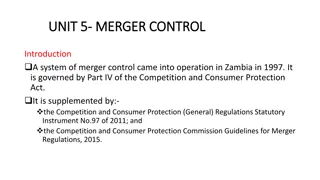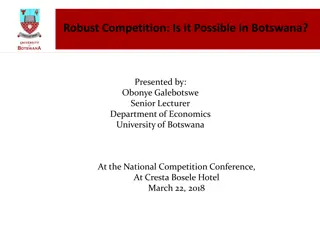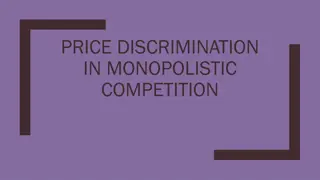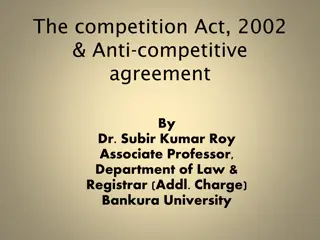Understanding Market Structures and Competition
Exploring market structures such as perfect competition and monopolies, this content delves into the characteristics, implications, and types of different market environments. Perfect competition involves many buyers and sellers offering identical products, whereas monopolies arise from barriers preventing competition, leading to potential overcharging. The content discusses natural and government monopolies, as well as price discrimination practices. Imperfect competition includes monopolistic competition and oligopolies, highlighting deviations from perfect competition conditions.
Download Presentation

Please find below an Image/Link to download the presentation.
The content on the website is provided AS IS for your information and personal use only. It may not be sold, licensed, or shared on other websites without obtaining consent from the author. Download presentation by click this link. If you encounter any issues during the download, it is possible that the publisher has removed the file from their server.
E N D
Presentation Transcript
Perfect Competition The market structure called perfect competition has the following conditions: 1. Many buyers and sellers participating in the market 2. Sellers offer identical products
Perfect Competition 3. Buyers and sellers are well informed about products 4. Sellers are able to enter and exit the market freely
Perfect Competition Yet perfect competition almost never happens. Imperfect competition refers to any market structure that is missing 1 or more of the characteristics of perfect competition.
Perfect Competition Imperfect market structures include: monopolies, monopolistic competition and oligopolies.
Monopolies A monopoly forms when barriers prevent firms from entering a market that has a single supplier. It is bad because they can overcharge
Monopolies Different types of monopolies: Natural monopolies- a market that runs most efficiently when one large firm supplies all of the output. Government permits and regulates existence. Ex. Public water works
Monopolies Government monopolies- created by government by giving patents and licenses that give inventors exclusive rights to sell a product or service for a period of time. Ex. Postal Service
Monopolies Price discrimination- division of customers into groups based on how much they will pay for a good. Ex. Sr. discounts, student discounts & manufacturer rebates.
Monopolistic Competition and Oligopoly So far we learned about two extremes: perfect competition and monopoly. Very few things actually fall into those categories. Instead, most fall into two additional categories economists call monopolistic competition and oligopoly.
Monopolistic Competition and Oligopoly In monopolistic competition, many companies compete in a open market to sell products that are similar but not identical. Examples: jeans, bread (loaf), shoes, drinks, etc.
Four Conditions of Monopolistic Competition 1. Many firms: many companies selling products 2. Few barriers to entry: anyone can sell products without much trouble getting started
Four Conditions of Monopolistic Competition 3. Slight control over price: consumers are willing to pay more for some brands, but not too much more. 4. Differentiated products: even though products are similar, they have differences (Samsung v iPhone) (differentiation: making a product different from other similar products)
Non Price Competition Firms try to compete with non-price competition, or attracting customers through style, service, or location, but not a lower price.
Non Price Competition 1. Physical Characteristics: size, color, shape, texture, taste Example: A pen is a stick with ink that writes, but we pay more for style or how it writes.
Non Price Competition 2. Location: Location is very important to a business's success. 3. Service level: restaurants: are expensive. Fast food: cheap. Both offer food.
Non Price Competition 4. Advertising, image or status: Customers are willing to pay more for brand name clothes with logos
Oligopoly An oligopoly is a market dominated by two to four firms producing 70%-80% of the output. Example: Pepsi, Coke
Oligopoly Barriers to Entry It can be tough to go up against these companies. Who would want to create a new soft drink to challenge Pepsi or Coke?
Oligopoly Price war: a series of competitive price cuts that lower the market price below the cost of production example: PS3 lowers price, so does Xbox and Nintendo Collusion: when businesses get together and set prices, divide the market, or limit production (illegal)
Oligopoly Price fixing: an agreement among firms to charge one price for the same good (illegal) Cartel: a formal organization of producers that agree to coordinate prices and production (illegal in the US)
Market Power Sometimes firms practice predatory pricing, or selling a product below cost to drive competitors out of the market.
Government and Competition Antitrust laws: laws that encourage competition Trust: like a cartel; an illegal grouping of companies that discourages competition
Government and Competition The US Gov. tries to make sure businesses act appropriately. The Federal Trade Commission makes sure that firms do not force out competition. In 1890, the Sherman Antitrust Act gave the federal government the power to break up monopolies. In 1982, US Gov. broke up ATT into 7 phone companies; prices did get lower.
Government and Competition Merger: the combination of two or more companies into a single firm Sometimes the gov. tries to block mergers if they think it will not benefit the people. Generally, mergers mean less competition, and less comp. means higher prices.
Deregulation Deregulation: the removal of some government regulations/control over the industry are eliminated Sometimes deregulation works great. Other times, it fails terribly.
Deregulation Banks were deregulated 10 years ago. Profits skyrocketed. But today, we are seeing the backlash of no regulation. California deregulated their electricity about 10 years ago. Remember when we had blackouts all the time? Deregulation was a total failure in that instance.























